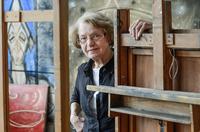Věra Nováková Whence come you, and whither are you going?
Galerie Středočeského kraje / Gallery of the Central Bohemian Region
15 June 2014 – 31 August 2014
Curator David Bartoň
Whence come you, and whither are you going?
Life is like walking a tightrope that is stretched from one place to another, whence and whither we know not. We have only the rope beneath our feet, these few moments in the world around us, voices, the reaction of the crowd. Particularly at the halfway point the rope becomes quite slack, swaying powerfully, and one must hold on to a fairly long balancing pole. Dante knew what he was talking about. Whereas the thread spun by Clotho is steadier at the beginning and just before the end, it is all the more uneven and slippery.
“Is it possible to speak intelligently of angels in the modern world? Will the psyche of the modern reader consent to be called a soul?” asks the poet Richard Wilbur. Today, the word soul means almost nothing except the stale, flat counterpart to the body in idiotic sermons by moralists on the values of yesterday. The barrage of production managing imbeciles urges the walker along the tightrope at a tempo that is never his own. He need not even fall. It’s enough that his enjoyment of the walk is lost — that is the soul running out.
Plato’s Socrates asks: “Whence come you, and whither are you going, young Phaedrus?” Phaedrus is a figure entirely of today. He is like a sponge soaking up news and opinions from the media. He is glued together, composed of something without his participation. He is an aesthete, a perfumed and urbane snob and nitwit of others’ opinions. He is a career man with a cultivated sense of status and honor, a man of society, never alone. He is reasonable and sedulously on guard lest he go to extremes. His soul — if he has one — is not his own. It is a piece of sponge drenched and sodden with everything.
Socrates of course is an extremist. Apart from the Cynics, who would want to lead his life? He is passé; he has his own unique path along the tightrope, his own tempo and particular methods, his own opinions and his own authentic ignorance. He is inflexible and inadaptable. There is not a pore on him open to absorb the knowledge of others because everything enters into him via a single entrance, which is carefully scrutinized, recast, and purified. Socrates is unseemly (ATOPOS) like atopic eczema. He does not wreak havoc in a single place; atopic Socrates wreaks havoc throughout the community and throughout the soul, among wise men and fools. He also dresses unseemly, sometimes he stinks, sometimes he doesn’t wash. He does not have the time. What is one to do if one does not do what one is supposed to?
Why did he not choose, like Paris did, perfection in one area — a passionate relationship (Aphrodite), a family (Hera), a career (Athena)? Today such a selection is real. No one could want for anything more. It didn’t pay off for for Paris, Helen, or the Trojans, not even for the Danaans. It is paid for with the loss of one’s own tempo, one’s own path, and thus with the loss of one’s soul.
The terms of the path are given, but terms are not reasons. The reasons for Socrates’s behavior are within, terms without — to blame the terms is shameful, and adducing them as reasons is cowardly. It is impossible to reconstruct the world.
Socrates is an artist. He speaks beautifully about the countryside outside the city, about myths, about the soul and its improvement when gazing upon the beautiful. His beautiful speech enchants Phaedrus. Will it save him? And return to him his tightrope and pace? The conversation with Phaedrus ends with Socrates’s: “Let us go.”
David Bartoň
The exhibition is introduced via a conversation between Karel Oujezdský and Richard Drury with Věra Nováková.



